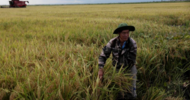eghtesadnews | 4 July 2022
Russia's green light to Iran for extraterritorial cultivation; 100 thousand hectares of land available to Iranian farmers!
(Note: this is a Google translation. Original is here)
One of the dreams that has existed in our country for a long time is self-sufficiency in the production of strategic agricultural products such as wheat, oilseeds, livestock inputs, etc. .. have been. An event that requires water resources in different provinces, but due to the consecutive droughts of these years and the lack of water resources in many provinces, this self-sufficiency has not happened for a long time, and this issue has led to the mention of a plan called trans-territorial cultivation. Since about 85% of the country's fresh water is used in agriculture, this project can be both a shortcut for agricultural development and the restoration of the country's water resources. Not long ago, Russia also offered to provide 100,000 hectares of land to Iran for trans-territorial cultivation, which made us write in this report about this plan, its advantages and the experiences of other countries from trans-territorial cultivation.
(Note: this is a Google translation. Original is here)
One of the dreams that has existed in our country for a long time is self-sufficiency in the production of strategic agricultural products such as wheat, oilseeds, livestock inputs, etc. .. have been. An event that requires water resources in different provinces, but due to the consecutive droughts of these years and the lack of water resources in many provinces, this self-sufficiency has not happened for a long time, and this issue has led to the mention of a plan called trans-territorial cultivation. Since about 85% of the country's fresh water is used in agriculture, this project can be both a shortcut for agricultural development and the restoration of the country's water resources. Not long ago, Russia also offered to provide 100,000 hectares of land to Iran for trans-territorial cultivation, which made us write in this report about this plan, its advantages and the experiences of other countries from trans-territorial cultivation.
What is trans-territorial cultivation?
Since some countries do not have sufficient water resources or suitable land for agriculture, they invest in the fertile lands of countries with suitable land and sufficient water to provide the basic products they need. Basically, trans-territorial cultivation means exploiting the resources, factors, capacities and facilities of other countries to produce agricultural products needed in order to preserve production resources and improve food security. This type of cultivation has been in use in our country for several years, and now due to the occurrence of drought in many provinces, the severe limitation of water resources and its impact on people's living conditions are more visible than ever.
The history of trans-territorial cultivation
The history of trans-territorial cultivation in the world dates back to 25 years ago, i.e. 1997 AD. In our country, since 1995, activities for trans-territorial cultivation were formed through the Ministry of Agricultural Jihad, and it was decided to introduce people under the name of "Green Jihad" company with the introduction of the Ministry of Agriculture, but this issue was not realized. Of course, according to Mehr's report, people have started activities spontaneously in Georgia, Ukraine, Tajikistan and African countries. including growing grains and creating vegetable and summer greenhouses with personal investments and without using Iran's facilities and foreign exchange resources or registering the company in the target countries.
Iran's share of trans-territorial cultivation; Almost nothing
In early June of this year, a Russian business delegation during its trip to Iran suggested that Iran acquire more than 100,000 hectares of agricultural land in Russia and carry out "extra-territorial agriculture". This proposal is unprecedented in its kind, and due to the sanctions imposed by Iran and Russia, it may be closer to implementation than ever. However, according to statistics, in the crop year of 1399 to 1400, the cultivated area of crops in Iran is reported to be about 12 million hectares. In fact, the proposal to allocate 100,000 hectares of agricultural land to Iran in Russia will be equivalent to about 0.8 percent (or less than one percent) of the entire cultivated area in Iran, which is a very small amount compared to the cultivated area in our country. Of course, Ali Rezvanizadeh, the chairman of the board of directors of the Trans-Territorial Cultivation Association, said in an interview with IRNA: "In order to provide food security for the country and minimize our import needs, we must plan and implement the target of cultivation in 7 million hectares. "But now we have only been able to realize less than 11% of 7 million hectares." However, other countries, including Armenia, have made proposals for cultivation in that country, which can help to increase the extraterritorial cultivation of our country.
Advantages of trans-territorial cultivation
1- According to experts, the first and most important advantage of trans-territorial cultivation is preventing water wastage. Considering the severity of the water crisis in the country, steps should be taken to make the existing agriculture more productive and use irrigation and planting methods, and take new steps to harvest and plant water-bearing crops in other countries and create trans-territorial cultivation.
2- The second advantage of this plan is the increase in the production of agricultural products and the peace of mind of providing food security. According to the statistics announced by the Ministry of Jihad and Agriculture, 90% of the oil products and a significant part of the rice consumed in the country are imported.
3- By using agricultural lands outside the country, rest of domestic lands is guaranteed and this issue causes agricultural lands to restore their water and soil. In addition, a large part of our needs is provided by agricultural products.
4- For this reason, there is nothing wrong with Iranian farmers cultivating and producing strategic crops such as wheat, animal feed, and oilseeds outside the borders of the country and using them to meet domestic needs. In addition, converting technology and knowledge into products is one of the advantages of trans-territorial cultivation.
The experience of other countries in trans-territorial cultivation
As we wrote before, trans-territorial cultivation started 25 years ago, and America tried to lower the cost of agricultural products by cultivating in countries that had cheaper labor, and now it is one of the countries with the largest amount of trans-territorial cultivation. has the According to international reports, China currently has the largest trans-territorial rice cultivation project, which is being implemented in Mozambique, Africa. For several years now, due to the problem of lack of grain production in its country, India has started trans-territorial cultivation and has started producing agricultural and garden crops in Australia in the past few years. They have bought agricultural land in Australia.
Of course, in the meantime, the UAE should not be neglected because this country has been investing in Sudan's agricultural industry for almost 10 years and has managed to cultivate almost 280,000 hectares of land around Khartoum. Also, by signing a memorandum of understanding with the Ministry of Agriculture of Pakistan, he has been able to plant 325 thousand hectares of Pakistan's land under rice and wheat cultivation. In recent years, the UAE plans to become the first producer of agricultural products among the countries of the Persian Gulf region by increasing its trans-territorial cultivation.













